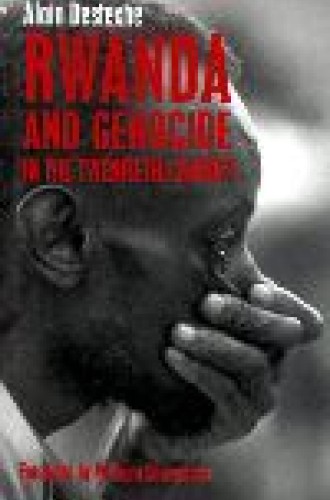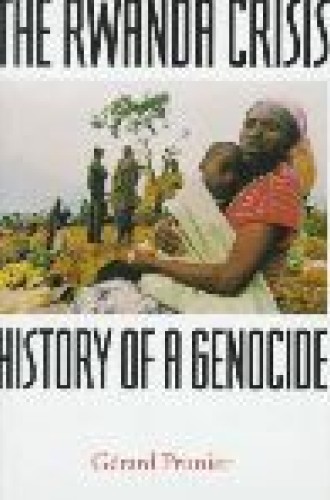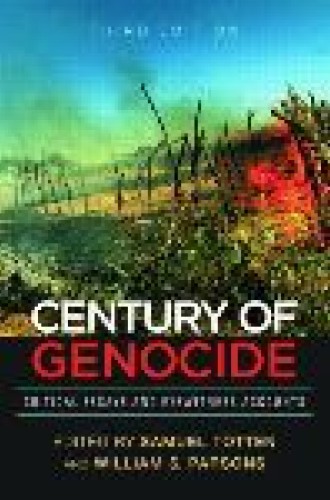Never again?
I vividly remember riding in a car during the summer of 1994 and listening with rapt attention to an account of the tragedy in Rwanda. In just 100 days, following a government coup in early April, some 800,000 Rwandans were ruthlessly murdered by their countrymen. When I arrived home, I located Rwanda on a map. For several weeks I paid close attention to reports of the refugee crisis that followed the slaughter. But then the genocide and its aftermath were mentioned less and less frequently by the news media and, like most Westerners, I stopped thinking about it. Later, when Rwanda did enter my mind, I had difficulty remembering who had killed whom. Had Tutsis been the victims of Hutus? Or was it the other way around?
While popular interest in Rwanda has waned in the years since the genocide, the literature of description and analysis continues to grow. Mahmood Mamdani’s When Victims Become Killers is a detailed account of the political conditions underlying the Rwandan tragedy. While it devotes little attention to the killing per se or to the individuals who committed it, it sheds a great deal of light on Rwandan history and political institutions—precolonial, colonial and revolutionary. One notable feature of Mamdani’s analysis is his recurrent mention of parallels between Rwanda and the Holocaust.
In fact, most studies of the Rwandan slaughter refer to the Nazi Final Solution. Apparently, the landscape of contemporary genocide is so dominated by the Holocaust that other tragedies remain invisible unless they are compared to it. As arguments for the uniqueness of the Jewish experience have multiplied over the past decade, students of genocide in other places—in Armenia, the Americas, the Balkans—have combated that argument with attention to understudied cases of genocide.
Philip Gourevitch introduces his riveting account of the Rwandan crisis and its aftermath (We Wish to Inform You . . .) with the observation that “the dead of Rwanda accumulated at nearly three times the rate of Jewish dead during the Holocaust. It was the most efficient killing since the atomic bombings of Hiroshima and Nagasaki.” One of the first books on the subject, Alain Destexhe’s Rwanda and Genocide in the Twentieth Century, begins with a quote from Holocaust survivor Primo Levi: “It has happened once, and it could all happen again.”
But references to the Holocaust reflect more than competition for the attention of atrocity-numbed readers. The two tragedies share quite a few formal similarities. There are analogous stories of unprovoked cruelty and betrayal, of rescue and gratuitous kindness, of hiding, passing and surviving. There are similar rationalizations on the part of perpetrators and bystanders—self-exculpating images of entrapment, of killers having no choice but to act as they did. There is similar evidence of complicit Christian leaders and institutions, evidence that poses a challenge to the credibility of faith.
There are the same pregenocidal legal persecutions used to identify and stigmatize an ethnic minority (including quotas and identity cards); the same essentializing of “race” that casts one group as a threat to the other’s survival; the same mystification of a minority as a strangely powerful entity against whom the majority must defend itself; the same dehumanizing of the victims through images (“rats” in Germany; “cockroaches” in Rwanda) that makes elimination easier once the genocide begins. And there are the same painstaking attempts afterwards to discover why some people killed their neighbors while others protected them, along with the same amazement at the latter’s refusal to consider their behavior extraordinary.
Like Nazi Germany, genocidal Rwanda is an exceedingly unattractive venue for Christian self-examination. Much of the evidence indicates that “blood” proved thicker than baptismal water, that faith was powerless to overcome the interests of class or ethnicity. And Rwanda has provided few stories designed to restore our trust in humankind or the role of faith in confronting evil. So far, we know of no Rwandan Bonhoeffers with whom mainline Protestants can identify; no Hutu Corrie ten Booms to sustain evangelicals’ belief that God protects the righteous; no Catholic bishops who risked their lives to speak out against the violence; no Le Chambon-sur-Lignons where the persecuted were sheltered by simple Christians in a “conspiracy of goodness.”
Yet precisely because so little good news can be gleaned from the Rwandan genocide, Christians must not ignore it. One pressing issue raised by Rwanda is human nature, what theologians have traditionally called anthropology. Although scholars of the genocide assiduously avoid theological questions, Christians must ask what this and other episodes of mass killing reveal about the essence and extent of our fallenness.
Reinhold Niebuhr reportedly said that the doctrine of original sin is the only doctrine for which Christians have any empirical evidence. If Niebuhr is correct, certainly the most compelling evidence for original sin is to be found in the study of mass murder. Considering this evidence theologically does not require that we ignore the communal and systemic dimensions of evil highlighted by social scientists, but it does help explain how easily human beings become complicit in the destruction of others—through abhorrence of difference, self-deception and the idolatry of race and nation.
Even more than the Holocaust, Rwanda pushes us to ask what adaptations or situational factors exacerbate the genocidal tendencies in human nature. Because it was extraordinarily low-tech, the Rwandan genocide does not allow us to take refuge in impersonal categories such as “bureaucratization” or “modernity.” The killing was perpetrated not anonymously in gas chambers, but face to face with machetes, knives, guns and grenades. It was carried out not by a class of professional killers “doing their duty,” but by bands of ordinary people that included women and children.
Rwanda also presents us with a stark reminder of the narrowness of national interests and the hollowness of official commitments to moral actions when they conflict with those interests. Both Gourevitch’s book and the television documentary “The Triumph of Evil” argue that the Rwandan genocide might well have been averted if the UN or its member nations had acted on information received in January 1994 from a UNAMIR (United Nations Mission in Rwanda) field commander.
An informant close to Hutu Power extremists in the Rwandan government revealed that the militias he was charged with training had been formed not for protection from the RPF (a guerrilla army of Rwandan exiles) but for the extermination of Tutsis. UNAMIR’s message to New York detailed his account of the Rwandan government’s plans: “He has been ordered to register all Tutsi in Kigali. He suspects it’s for their extermination. Example he gave was that in 20 minutes his personnel could kill up to 1,000 Tutsis.”
Since the Hutu informant revealed the location of arms to be used for this grisly task, the UNAMIR commander requested permission to seize the weapons and protect the informant and his family. The information and request were discussed by key members of the UN staff and then ignored. Motivated by the desire to avoid “another Somalia,” the commander’s superiors prohibited him from taking any action.
Three months later, events in Rwanda unfolded just as the informant had predicted. The morning after President Juvénal Habyarimana’s plane was shot down under suspicious circumstances, ten Belgian peacekeepers were kidnapped, tortured and mutilated as a warning to the Western democracies. Then the genocide was on: roadblocks were set up and marauding death squads (interahamwe) took the streets, encouraged and directed by broadcasts on national radio; educated professionals massacred their colleagues in churches and hospitals; Tutsis and moderate Hutus attempted to flee or cowered in embassies and hotels protected by foreign interests; white citizens of Western nations were evacuated amid heart-wrenching pleas for help by desperate Africans; and UNAMIR troops ignominiously withdrew from their compounds, leaving those who had sought their protection to be hacked to death.
As corpses began to rot in the streets and clog the rivers, the Western response to this maelstrom of genocidal evil was precisely what Hutu Power extremists had hoped for. Under pressure from Belgium and the United States, the UN Security Council voted to terminate its mission in Rwanda. While American and UN representatives steadfastly refused to utter the word “genocide,” the Czech Republic’s ambassador to the UN spoke to the point: “When you come from Central Europe, [you have] a sense of what holocausts are about; you recognize one when you see one.”
All of which leads to a troubling question: If one of the Nazi leaders present at the Wannsee Conference in Berlin in January 1942 had—in a fit of conscience—leaked plans for the “Final Solution of the Jewish Question in Europe” to the Allies, would this information have altered the fate of Jews under Nazi control?
The Western response to the genocidal crisis in Rwanda suggests that the answer is no. There is every reason to believe that Allied government officials would have treated a leaked Wannsee protocol as irrelevant to their strategic interests. And recall that in 1942 Western democracies had neither the experience of the Holocaust to reflect on nor a political obligation under the UN’s Genocide Convention to prevent genocide.
Thus, while our consciousness of mass death and our use of the word “genocide” have been thoroughly conditioned by the Holocaust, it is not at all clear that Holocaust awareness has made Western democracies or their citizens more sensitive to mass death, or more committed to incurring personal risk to stop it. This despite the fact that “never again”—the ubiquitous mantra of Holocaust remembrance—indicates a commitment on the part of the powerful and morally aware “never again” to stand by while a nation destroys those it deems a threat to its survival.
As the documentary “The Triumph of Evil” so poignantly demonstrates, it was only a few months after ceremonies marking the opening of the U.S. Holocaust Memorial Museum—ceremonies at which President Clinton vowed on behalf of all Americans “to preserve this shared history of anguish, to keep it vivid and real so that evil can be combated and contained”—that warnings of the Rwandan tragedy reached the White House. In April 1994, just a few weeks after Schindler’s List claimed the Oscar for best picture, Vice President Al Gore proclaimed that Washington’s Holocaust memorial was needed “to remind those who make the agonizing decisions of foreign policy of the consequences of those decisions.” Meanwhile, his government was rejecting State Department proposals to impede the genocide and worrying about whether its refusal to act might hurt the party in upcoming mid-term elections. It is difficult to imagine a more dramatic example of the yawning gap between rhetoric and reality in contemporary politics.
While our culture is awash in images of a genocide that ended over 50 years ago, we have trouble remembering the victims of a genocidal assault that occurred within the past decade. Is it simply the passage of time that fixes international tragedies in our consciousness? More likely it is a function of what Richard L. Rubenstein has identified as a fundamental dimension of the Holocaust’s “uniqueness”—its resonance with the biblical and theological motifs that animate Judeo-Christian civilization.
Yet perhaps the failure of Rwanda’s tragedy to penetrate the Western mind has to do with geography and race as well. Perhaps Westerners perceive the Holocaust not only through a religious grid, but through the prism of color. Ironically, given the explicit racial dimensions of Nazi ideology, both perpetrator and victim in the Holocaust are perceived as vaguely “white.” Even in the Balkans, the difficult-to-pronounce names and unfamiliar traditions notwithstanding, we perceive victims who “look like us.”
Rwanda, however, is a different story. The mental maps of most Americans simply do not include East Africa. The crises there—even when they reach the threshold of media consciousness—seem far away, the historical and political contexts unfamiliar, the “tribes” involved indistinguishable. Unless a conflict pits “white” against “black,” as in South Africa or Zimbabwe, it does not hold our attention for long. Is it possible that we find it difficult to forge a connection with victims of genocide unless we can identify with them on the level of ethnicity, religious affiliation or color? If so, herein lies another grim lesson regarding human nature.
What can Christians who want to remember Rwanda learn from this genocide? Most scholarly analyses ignore the religious dimensions of the tragedy, portraying the Hutu extermination campaign as an indictment of European colonialism or a metaphor for the dilemmas of post-cold-war foreign policy. But there are important exceptions. For instance, Timothy Longman’s contribution to In God’s Name: Genocide and Religion in the Twentieth Century documents the active involvement of church personnel and institutions in the genocide: “Numerous priests, pastors, nuns, brothers, catechists, and Catholic and Protestant lay leaders supported, participated in, or helped to organize the killings,” Longman writes. And he remarks that more people may have been killed in church buildings than anywhere else.
In the same volume, Charles de Lespinay charges the Rwandan clergy of being “propagators of false information tending to maintain a climate of fear, suspicion and hatred.” Prominent clergy refused to condemn the killing (characterizing it as wartime self-defense or “double genocide”), and even excused the murders as a sort of delayed justice for past wrongs. In Rwanda, Lespinay concludes, “the exacerbation of past and present rivalries is entirely the fault of the missionary-educated intellectual ‘elites.’”
But the religious lessons from Rwanda transcend the genocidal behavior of believers in one of Africa’s most Christianized societies (90 percent Christian and 63 percent Roman Catholic, according to a 1991 census). Rwanda also reminds us of the way biblical myths of origin can exercise a pernicious influence in history. As almost every commentator on the genocide has noted, the antagonism between Hutu and Tutsi is based on presumed racial distinctions constructed from a quasi-biblical ideology introduced by 19th-century white explorers and reiterated by European colonialists who benefited from inter-African antagonism.
The intellectual foundation for the construction of racial difference in Rwanda is John Hanning Speke’s Journal of the Discovery of the Source of the Nile (1863, reprinted in 1996). Like other 19th-century Westerners, the English explorer assumed that Africans were descendants of “our poor elder brother Ham [who] was cursed by his father, and condemned to be the slave of both Shem and Japheth.” Speke’s contribution to white perceptions of Africa was a theory of ethnology “founded on the traditions of the several nations, as checked by [his] own observation of what [he] saw when passing through them.”
The distinctive physical appearance of the Wahuma (Tutsis) led Speke to surmise that they were descended from “the semi-Shem-Hamitic of Ethiopia,” cattle-herding “Asiatic” invaders who moved south, lost their original language and religion, and darkened through intermarriage. According to his journal, Speke elaborated his ethnological theory for a Tutsi king using the Book of Genesis “to explain all [he] fancied [he] knew about the origin and present condition of the Wahuma branch of the Ethiopians, beginning with Adam, to show how it was the king had heard by tradition that at one time the people of his race were half white and half black.”
In the Western mind this so-called Hamitic Hypothesis evolved to become an explanation for the arrival of “civilization” in Africa. Inside Rwanda, it was adopted as the basis for colonial theories of Tutsi superiority, for missionary education that placed ethnic diversity in a European class perspective, and for the Hutu revolutionary image of Tutsis as nonindigenous invaders from the north. While this “biblical” dimension of Rwandan history is rarely reported, it was well known to both the perpetrators and the victims of the genocide.
Rwanda also presents us with compelling evidence for the ineptitude of Christian leaders and institutions in resisting genocidal evil. Even as we struggle to understand the failure of Christian witness and action during the Holocaust, Rwanda raises new specters: of churches becoming killing sites, of parishioners murdering each other, of pastors being sought as war criminals, and of priests denying or excusing mass murder.
As Longman argues, one reason Christians failed to resist the forces that led to genocide was the Rwandan church’s close relationship with the Habyarimana government and the refusal of church leaders to support groups and individuals advocating reform. The church’s commitment to preserving the status quo helps explain its “resounding silence” in the wake of sporadic persecutions during the early 1990s, and all-out genocide in 1994.
Stories from Rwanda—like so many stories from the Holocaust—force us to ask how we would have behaved in a similar situation, whether we are different from the perpetrators and bystanders who became agents of genocide. These questions are faced with disturbing honesty in James Waller’s forthcoming book Children of Cain: How Ordinary People Commit Extraordinary Evil. The book’s title is taken from Gourevitch’s application of Genesis 4 to the Rwandan tragedy: “In the famous story, the older brother, Cain, was a cultivator, and Abel, the younger, was a herdsman. They made their offerings to God—Cain from his crops, Abel from his herds. Abel’s portion won God’s regard; Cain’s did not. So Cain killed Abel.” In offering a unified theory of perpetrator behavior, Waller discredits the various psychological mechanisms we rely upon to distance ourselves from those who commit or countenance genocide.
Finally, because it reveals how the world’s leading democracy conspired to ignore and deny an ongoing genocide at the very moment when American consciousness of the Holocaust was at its height, Rwanda forces Christians to ask precisely how Holocaust awareness contributes to antigenocidal thought and action. When we say “never again,” we must pledge to remember Rwanda.









